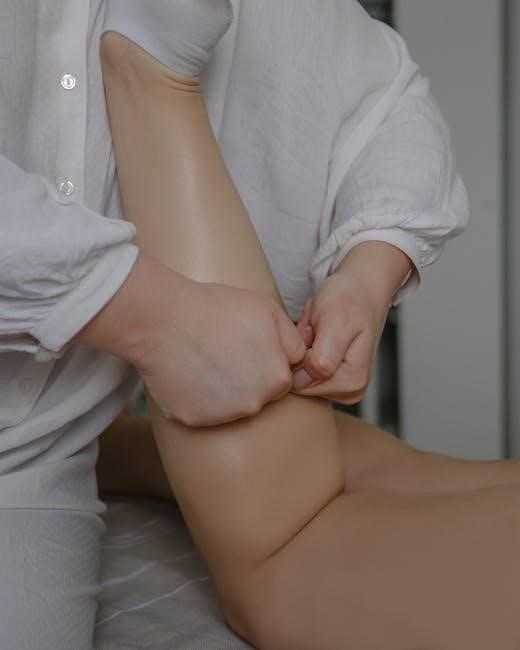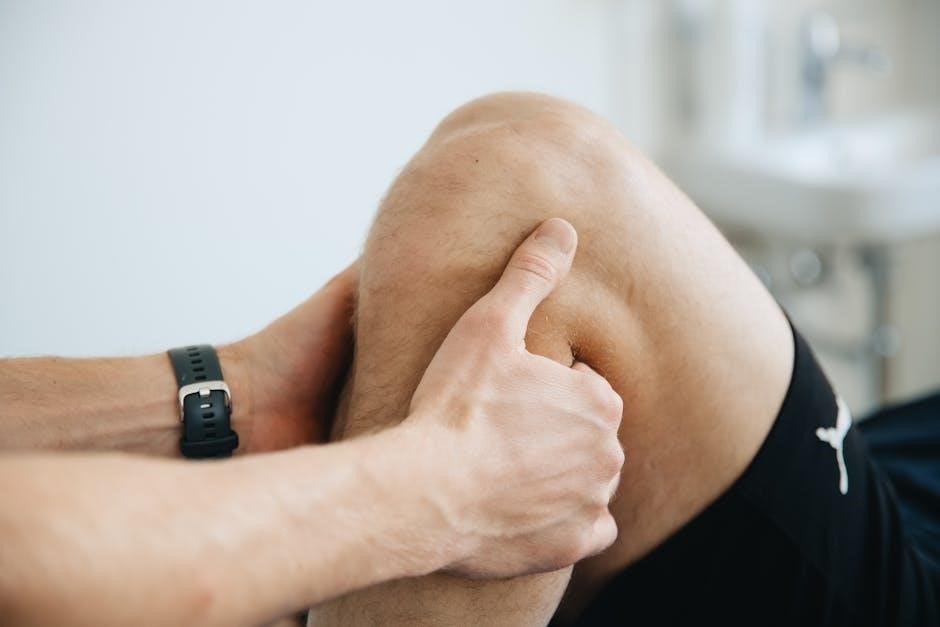
The sacroiliac (SI) joint connects the sacrum and ilium bones, playing a crucial role in supporting the spine and pelvis. It absorbs shock and enables flexible movement during activities like walking or bending. Dysfunction in this joint can lead to lower back pain, making it essential to understand its structure and function when addressing pain relief through stretches and exercises.
1.1 What is the SI Joint?
The sacroiliac (SI) joint is a critical anatomical structure located between the sacrum (the triangular bone at the base of the spine) and the ilium (the largest bone in the pelvis). It plays a vital role in connecting the spine to the pelvis, providing stability and facilitating movement. The SI joint is supported by strong ligaments and is lined with cartilage to reduce friction and absorb shock during activities like walking, bending, or lifting. While it allows for limited movement, its primary function is to transfer forces from the upper body to the lower limbs, ensuring proper biomechanics of the pelvis and spine. Dysfunction or inflammation in the SI joint can lead to pain, often felt in the lower back, buttocks, or legs, making it a common focus for stretches and exercises aimed at restoring mobility and alleviating discomfort. Understanding its structure and function is essential for addressing related pain effectively.

1.2 Causes and Symptoms of SI Joint Pain
Sacroiliac (SI) joint pain arises from inflammation, dysfunction, or instability in the joint. Common causes include trauma, repetitive stress, pregnancy (due to hormonal changes and weight distribution), arthritis, or muscle imbalances. Symptoms often present as lower back pain, radiating to the buttocks, thighs, or legs. Pain may worsen with activities like sitting, lifting, or bending. Some individuals experience stiffness, limited mobility, or a sensation of instability in the pelvis. Proper diagnosis is essential, as SI joint pain can mimic other conditions like sciatica or herniated discs. Identifying the root cause is crucial for effective treatment, which often involves targeted stretches and exercises to restore joint function and alleviate discomfort. Early intervention can prevent chronic pain and improve quality of life. Consulting a healthcare professional is recommended for personalized care and to rule out other potential causes of symptoms.

Effective Stretches for SI Joint Pain
Targeted stretches can alleviate SI joint pain by improving flexibility and reducing stiffness. Common exercises include the Single Knee-to-Chest Stretch, Hamstring Stretch on Wall, Piriformis Muscle Stretch, and Bridge Exercise. These stretches help restore joint mobility and relieve discomfort when performed correctly. Always consult a healthcare professional to tailor a routine to your specific needs.
2.1 Single Knee-to-Chest Stretch
The Single Knee-to-Chest Stretch is a simple yet effective exercise for alleviating SI joint pain. To perform this stretch, lie on your back with your knees bent and feet flat on the floor. Slowly bring one knee toward your chest while keeping the other foot on the ground. Wrap your hands around the knee and gently pull it closer to your chest until you feel a comfortable stretch in your lower back and buttocks. Hold this position for 20-30 seconds, then slowly release. Repeat the stretch 2-3 times on each side. This exercise helps relax the gluteal muscles and improves flexibility in the SI joint, reducing stiffness and discomfort. It is important to breathe deeply and avoid bouncing or forcing the stretch beyond a pain-free range. Regular practice of this stretch can significantly contribute to SI joint pain relief and overall pelvic mobility.
2.2 Hamstring Stretch on Wall
The Hamstring Stretch on Wall is an excellent exercise for targeting tight hamstrings, which often contribute to SI joint pain. To perform this stretch, lie on your back with your buttocks close to a doorway and extend your legs straight out along the floor. Position one leg through the doorway, keeping it straight, while the other leg remains bent at a 90-degree angle. Slowly lift your straight leg toward the ceiling until you feel a gentle stretch in the back of your thigh. Hold this position for 15 to 30 seconds, then lower your leg and repeat 2-3 times. This stretch helps loosen tight hamstrings, which can reduce tension on the SI joint and alleviate pain. It is important to avoid bouncing or forcing the stretch beyond a comfortable range, as this could cause discomfort or injury. Regular practice of this stretch can improve flexibility and provide relief from SI joint-related discomfort.
2.3 Piriformis Muscle Stretch
The Piriformis Muscle Stretch is a highly effective exercise for alleviating SI joint pain, as tightness in the piriformis muscle often contributes to discomfort. To perform this stretch, lie on your back and place the affected leg across the other thigh, just above the knee. Gently pull the unaffected leg toward your chest until you feel a stretch in the buttock area of the affected side. Hold this position for 20 to 30 seconds, breathing deeply to relax the muscle. Repeat 2 to 3 times on each side. This stretch helps release tension in the piriformis muscle, which can indirectly reduce pressure on the SI joint. It is important to avoid bouncing or forcing the stretch, as this could exacerbate pain. Regular practice of this stretch can improve muscle flexibility and provide significant relief from SI joint-related discomfort. Consistency is key to achieving long-term benefits and preventing future flare-ups.
2.4 Bridge Exercise
The Bridge Exercise is a simple yet effective stretch for SI joint pain relief. To perform it, lie on your back with your knees bent and feet flat on the floor, hip-width apart. Slowly lift your pelvis toward the ceiling, squeezing your glutes and lower back muscles as you rise. Ensure your shoulders remain on the ground to maintain proper form. Hold the position for 5 to 10 seconds, then slowly lower your pelvis back to the starting position. Repeat this motion 10 to 15 times. This exercise strengthens the glutes and lower back muscles, which helps stabilize the SI joint and reduce pain. It also improves flexibility and promotes proper alignment of the pelvis. For best results, focus on controlled movements and avoid arching your back excessively. If you experience discomfort, start with smaller movements and gradually increase the range as your strength and flexibility improve. Consistency is key to achieving lasting relief.
How to Perform Stretches Safely
To ensure safe stretching, focus on proper technique, avoid forceful movements, and consult a healthcare professional if pain persists. Stop exercises if discomfort arises and prioritize gradual progression in flexibility.
3.1 Proper Technique and Posture
Maintaining proper technique and posture is crucial when performing stretches for SI joint pain. Start by warming up with gentle movements to prepare your muscles. For each stretch, focus on slow, controlled motions, avoiding bouncing or jerking, which can cause injury. Pay attention to your body positioning—lie on a firm surface with knees bent if needed, and use pillows for support. Keep your lower back pressed to the floor during stretches to maintain alignment and prevent strain. Breathing deeply can help relax the muscles, enhancing the stretch. Always follow instructions carefully, and if a stretch feels uncomfortable or causes pain, stop immediately. Proper posture ensures that the stretch targets the correct muscles without putting unnecessary stress on the SI joint. Consistency and mindfulness in technique will lead to safer and more effective pain relief.
3.2 Duration and Frequency of Stretches
To maximize the benefits of SI joint stretches, it’s important to adhere to proper duration and frequency; Hold each stretch for at least 1 minute to allow the muscles to relax fully. Over time, you can gradually increase the hold duration up to 6 minutes for deeper relief. Repeat each stretch 2 to 4 times to ensure thorough targeting of the affected areas. For optimal results, perform these stretches 1 to 2 times daily, ideally in the morning and evening. Consistency is key to alleviating pain and improving joint mobility. If you experience sharp pain or discomfort during a stretch, stop immediately and consult a healthcare professional. Adjusting the frequency based on your body’s response will help prevent overexertion and promote healing. Regular practice, paired with patience, will yield the best outcomes for SI joint pain relief.

Additional Tips for SI Joint Pain Relief
Consult a musculoskeletal physiotherapist to ensure exercises suit your recovery. Avoid stretches causing pain or discomfort. Incorporate stretches into your daily routine and seek professional help if pain persists or worsens.

4.1 Incorporating Stretches into Your Daily Routine
Incorporating SI joint stretches into your daily routine can significantly improve flexibility and reduce pain. Begin with gentle movements like the single knee-to-chhest stretch, holding each position for 15-30 seconds. Perform these exercises on a firm surface, such as a floor or sturdy table, to ensure proper alignment. Consistency is key; aim to practice stretches 2-4 times a day, gradually increasing the duration as comfort allows. For example, start with shorter holds and progress to longer durations, up to 6 minutes, to enhance flexibility. It’s also important to listen to your body and stop if any exercise causes sharp pain. Regular stretching can help maintain joint mobility and prevent stiffness, making it easier to perform daily activities without discomfort. Over time, these routines can become a natural part of your self-care regimen, promoting long-term relief from SI joint pain.
4.2 When to Consult a Healthcare Professional
While stretches can provide significant relief for SI joint pain, it’s crucial to know when to seek professional help. If your pain persists or worsens despite consistent stretching, consult a healthcare professional. Sharp, stabbing pains, numbness, or tingling in the legs or lower back are red flags that require medical attention. Additionally, if your pain exceeds a level of 4/10, it’s important to seek guidance from a musculoskeletal physiotherapist or chiropractor. They can ensure that your exercises are tailored to your specific condition and prevent further injury. A healthcare provider can also rule out other potential causes of pain, such as herniated discs or arthritis. Don’t hesitate to reach out if you experience difficulty performing daily activities or if your pain interferes with sleep. Professional intervention can provide personalized treatment plans and advanced therapies to address underlying issues effectively. Early consultation can lead to faster recovery and prevent long-term complications.